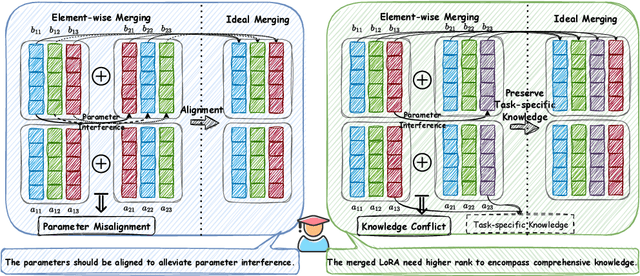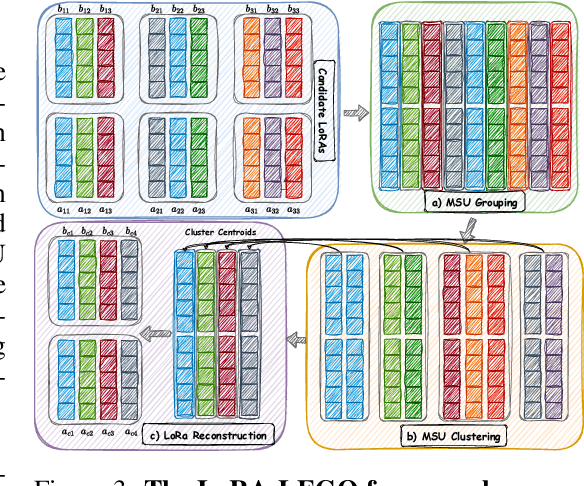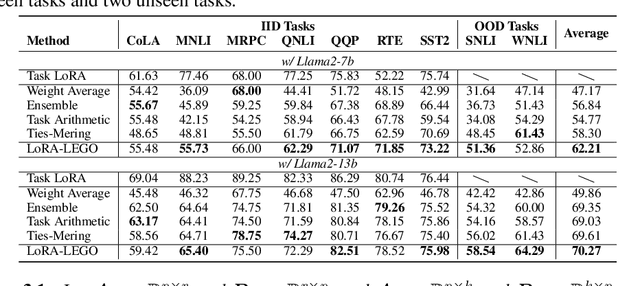Zexi Li
Editing as Unlearning: Are Knowledge Editing Methods Strong Baselines for Large Language Model Unlearning?
May 26, 2025Abstract:Large language Model (LLM) unlearning, i.e., selectively removing information from LLMs, is vital for responsible model deployment. Differently, LLM knowledge editing aims to modify LLM knowledge instead of removing it. Though editing and unlearning seem to be two distinct tasks, we find there is a tight connection between them. In this paper, we conceptualize unlearning as a special case of editing where information is modified to a refusal or "empty set" $\emptyset$ response, signifying its removal. This paper thus investigates if knowledge editing techniques are strong baselines for LLM unlearning. We evaluate state-of-the-art (SOTA) editing methods (e.g., ROME, MEMIT, GRACE, WISE, and AlphaEdit) against existing unlearning approaches on pretrained and finetuned knowledge. Results show certain editing methods, notably WISE and AlphaEdit, are effective unlearning baselines, especially for pretrained knowledge, and excel in generating human-aligned refusal answers. To better adapt editing methods for unlearning applications, we propose practical recipes including self-improvement and query merging. The former leverages the LLM's own in-context learning ability to craft a more human-aligned unlearning target, and the latter enables ROME and MEMIT to perform well in unlearning longer sample sequences. We advocate for the unlearning community to adopt SOTA editing methods as baselines and explore unlearning from an editing perspective for more holistic LLM memory control.
You Are Your Own Best Teacher: Achieving Centralized-level Performance in Federated Learning under Heterogeneous and Long-tailed Data
Mar 10, 2025Abstract:Data heterogeneity, stemming from local non-IID data and global long-tailed distributions, is a major challenge in federated learning (FL), leading to significant performance gaps compared to centralized learning. Previous research found that poor representations and biased classifiers are the main problems and proposed neural-collapse-inspired synthetic simplex ETF to help representations be closer to neural collapse optima. However, we find that the neural-collapse-inspired methods are not strong enough to reach neural collapse and still have huge gaps to centralized training. In this paper, we rethink this issue from a self-bootstrap perspective and propose FedYoYo (You Are Your Own Best Teacher), introducing Augmented Self-bootstrap Distillation (ASD) to improve representation learning by distilling knowledge between weakly and strongly augmented local samples, without needing extra datasets or models. We further introduce Distribution-aware Logit Adjustment (DLA) to balance the self-bootstrap process and correct biased feature representations. FedYoYo nearly eliminates the performance gap, achieving centralized-level performance even under mixed heterogeneity. It enhances local representation learning, reducing model drift and improving convergence, with feature prototypes closer to neural collapse optimality. Extensive experiments show FedYoYo achieves state-of-the-art results, even surpassing centralized logit adjustment methods by 5.4\% under global long-tailed settings.
Photon: Federated LLM Pre-Training
Nov 05, 2024



Abstract:Scaling large language models (LLMs) demands extensive data and computing resources, which are traditionally constrained to data centers by the high-bandwidth requirements of distributed training. Low-bandwidth methods like federated learning (FL) could enable collaborative training of larger models across weakly-connected GPUs if they can effectively be used for pre-training. To achieve this, we introduce Photon, the first complete system for federated end-to-end LLM training, leveraging cross-silo FL for global-scale training with minimal communication overheads. Using Photon, we train the first federated family of decoder-only LLMs from scratch. We show that: (1) Photon can train model sizes up to 7B in a federated fashion while reaching an even better perplexity than centralized pre-training; (2) Photon model training time decreases with available compute, achieving a similar compute-time trade-off to centralized; and (3) Photon outperforms the wall-time of baseline distributed training methods by 35% via communicating 64x-512xless. Our proposal is robust to data heterogeneity and converges twice as fast as previous methods like DiLoCo. This surprising data efficiency stems from a unique approach combining small client batch sizes with extremely high learning rates, enabled by federated averaging's robustness to hyperparameters. Photon thus represents the first economical system for global internet-wide LLM pre-training.
Merging LoRAs like Playing LEGO: Pushing the Modularity of LoRA to Extremes Through Rank-Wise Clustering
Sep 24, 2024



Abstract:Low-Rank Adaptation (LoRA) has emerged as a popular technique for fine-tuning large language models (LLMs) to various domains due to its modular design and widespread availability on platforms like Huggingface. This modularity has sparked interest in combining multiple LoRAs to enhance LLM capabilities. However, existing methods for LoRA composition primarily focus on task-specific adaptations that require additional training, and current model merging techniques often fail to fully leverage LoRA's modular nature, leading to parameter interference and performance degradation. In this paper, we investigate the feasibility of disassembling and reassembling multiple LoRAs at a finer granularity, analogous to assembling LEGO blocks. We introduce the concept of Minimal Semantic Units (MSUs), where the parameters corresponding to each rank in LoRA function as independent units. These MSUs demonstrate permutation invariance and concatenation-summation equivalence properties, enabling flexible combinations to create new LoRAs. Building on these insights, we propose the LoRA-LEGO framework. This framework conducts rank-wise parameter clustering by grouping MSUs from different LoRAs into $k$ clusters. The centroid of each cluster serves as a representative MSU, enabling the assembly of a merged LoRA with an adjusted rank of $k$. Additionally, we apply a dual reweighting strategy to optimize the scale of the merged LoRA. Experiments across various benchmarks demonstrate that our method outperforms existing approaches in LoRA merging.
WISE: Rethinking the Knowledge Memory for Lifelong Model Editing of Large Language Models
May 23, 2024Abstract:Large language models (LLMs) need knowledge updates to meet the ever-growing world facts and correct the hallucinated responses, facilitating the methods of lifelong model editing. Where the updated knowledge resides in memories is a fundamental question for model editing. In this paper, we find that editing either long-term memory (direct model parameters) or working memory (non-parametric knowledge of neural network activations/representations by retrieval) will result in an impossible triangle -- reliability, generalization, and locality can not be realized together in the lifelong editing settings. For long-term memory, directly editing the parameters will cause conflicts with irrelevant pretrained knowledge or previous edits (poor reliability and locality). For working memory, retrieval-based activations can hardly make the model understand the edits and generalize (poor generalization). Therefore, we propose WISE to bridge the gap between memories. In WISE, we design a dual parametric memory scheme, which consists of the main memory for the pretrained knowledge and a side memory for the edited knowledge. We only edit the knowledge in the side memory and train a router to decide which memory to go through when given a query. For continual editing, we devise a knowledge-sharding mechanism where different sets of edits reside in distinct subspaces of parameters, and are subsequently merged into a shared memory without conflicts. Extensive experiments show that WISE can outperform previous model editing methods and overcome the impossible triangle under lifelong model editing of question answering, hallucination, and out-of-distribution settings across trending LLM architectures, e.g., GPT, LLaMA, and Mistral. Code will be released at https://github.com/zjunlp/EasyEdit.
Text-to-Model: Text-Conditioned Neural Network Diffusion for Train-Once-for-All Personalization
May 23, 2024Abstract:Generative artificial intelligence (GenAI) has made significant progress in understanding world knowledge and generating content from human languages across various modalities, like text-to-text large language models, text-to-image stable diffusion, and text-to-video Sora. While in this paper, we investigate the capability of GenAI for text-to-model generation, to see whether GenAI can comprehend hyper-level knowledge embedded within AI itself parameters. Specifically, we study a practical scenario termed train-once-for-all personalization, aiming to generate personalized models for diverse end-users and tasks using text prompts. Inspired by the recent emergence of neural network diffusion, we present Tina, a text-conditioned neural network diffusion for train-once-for-all personalization. Tina leverages a diffusion transformer model conditioned on task descriptions embedded using a CLIP model. Despite the astronomical number of potential personalized tasks (e.g., $1.73\times10^{13}$), by our design, Tina demonstrates remarkable in-distribution and out-of-distribution generalization even trained on small datasets ($\sim 1000$). We further verify whether and how \Tina understands world knowledge by analyzing its capabilities under zero-shot/few-shot image prompts, different numbers of personalized classes, prompts of natural language descriptions, and predicting unseen entities.
Retrieving and Refining: A Hybrid Framework with Large Language Models for Rare Disease Identification
May 16, 2024Abstract:The infrequency and heterogeneity of clinical presentations in rare diseases often lead to underdiagnosis and their exclusion from structured datasets. This necessitates the utilization of unstructured text data for comprehensive analysis. However, the manual identification from clinical reports is an arduous and intrinsically subjective task. This study proposes a novel hybrid approach that synergistically combines a traditional dictionary-based natural language processing (NLP) tool with the powerful capabilities of large language models (LLMs) to enhance the identification of rare diseases from unstructured clinical notes. We comprehensively evaluate various prompting strategies on six large language models (LLMs) of varying sizes and domains (general and medical). This evaluation encompasses zero-shot, few-shot, and retrieval-augmented generation (RAG) techniques to enhance the LLMs' ability to reason about and understand contextual information in patient reports. The results demonstrate effectiveness in rare disease identification, highlighting the potential for identifying underdiagnosed patients from clinical notes.
Improving Group Connectivity for Generalization of Federated Deep Learning
Feb 29, 2024



Abstract:Federated learning (FL) involves multiple heterogeneous clients collaboratively training a global model via iterative local updates and model fusion. The generalization of FL's global model has a large gap compared with centralized training, which is its bottleneck for broader applications. In this paper, we study and improve FL's generalization through a fundamental ``connectivity'' perspective, which means how the local models are connected in the parameter region and fused into a generalized global model. The term ``connectivity'' is derived from linear mode connectivity (LMC), studying the interpolated loss landscape of two different solutions (e.g., modes) of neural networks. Bridging the gap between LMC and FL, in this paper, we leverage fixed anchor models to empirically and theoretically study the transitivity property of connectivity from two models (LMC) to a group of models (model fusion in FL). Based on the findings, we propose FedGuCci and FedGuCci+, improving group connectivity for better generalization. It is shown that our methods can boost the generalization of FL under client heterogeneity across various tasks (4 CV datasets and 6 NLP datasets), models (both convolutional and transformer-based), and training paradigms (both from-scratch and pretrain-finetune).
Model Tailor: Mitigating Catastrophic Forgetting in Multi-modal Large Language Models
Feb 19, 2024Abstract:Catastrophic forgetting emerges as a critical challenge when fine-tuning multi-modal large language models (MLLMs), where improving performance on unseen tasks often leads to a significant performance drop on the original tasks. This paper presents a comprehensive analysis of catastrophic forgetting in MLLMs and introduces a post-training adjustment method called Model Tailor. Our method primarily preserves the pre-trained parameters while replacing a small number ($\leq$ 10\%) of fine-tuned parameters, maintaining $\sim$ 99\% effectiveness on original tasks versus pre-training, and achieving $\sim$ 97\% on new tasks compared to standard fine-tuning. Specifically, we derive a sparse mask to identify the "model patch", based on a fusion strategy that integrates salience and sensitivity analysis. Subsequently, a compensation mechanism is introduced to "decorate the patch", enhancing the model's performance on both target and original tasks. Additionally, our method is adaptable to multi-task scenarios. Through extensive experiments on InstructBLIP and LLaVA-1.5 in both image captioning and visual question answering tasks, our approach demonstrates significant task adaptability while preserving inherent pre-trained capabilities.
OpenFedLLM: Training Large Language Models on Decentralized Private Data via Federated Learning
Feb 10, 2024Abstract:Trained on massive publicly available data, large language models (LLMs) have demonstrated tremendous success across various fields. While more data contributes to better performance, a disconcerting reality is that high-quality public data will be exhausted in a few years. In this paper, we offer a potential next step for contemporary LLMs: collaborative and privacy-preserving LLM training on the underutilized distributed private data via federated learning (FL), where multiple data owners collaboratively train a shared model without transmitting raw data. To achieve this, we build a concise, integrated, and research-friendly framework/codebase, named OpenFedLLM. It covers federated instruction tuning for enhancing instruction-following capability, federated value alignment for aligning with human values, and 7 representative FL algorithms. Besides, OpenFedLLM supports training on diverse domains, where we cover 8 training datasets; and provides comprehensive evaluations, where we cover 30+ evaluation metrics. Through extensive experiments, we observe that all FL algorithms outperform local training on training LLMs, demonstrating a clear performance improvement across a variety of settings. Notably, in a financial benchmark, Llama2-7B fine-tuned by applying any FL algorithm can outperform GPT-4 by a significant margin while the model obtained through individual training cannot, demonstrating strong motivation for clients to participate in FL. The code is available at https://github.com/rui-ye/OpenFedLLM.
 Add to Chrome
Add to Chrome Add to Firefox
Add to Firefox Add to Edge
Add to Edge